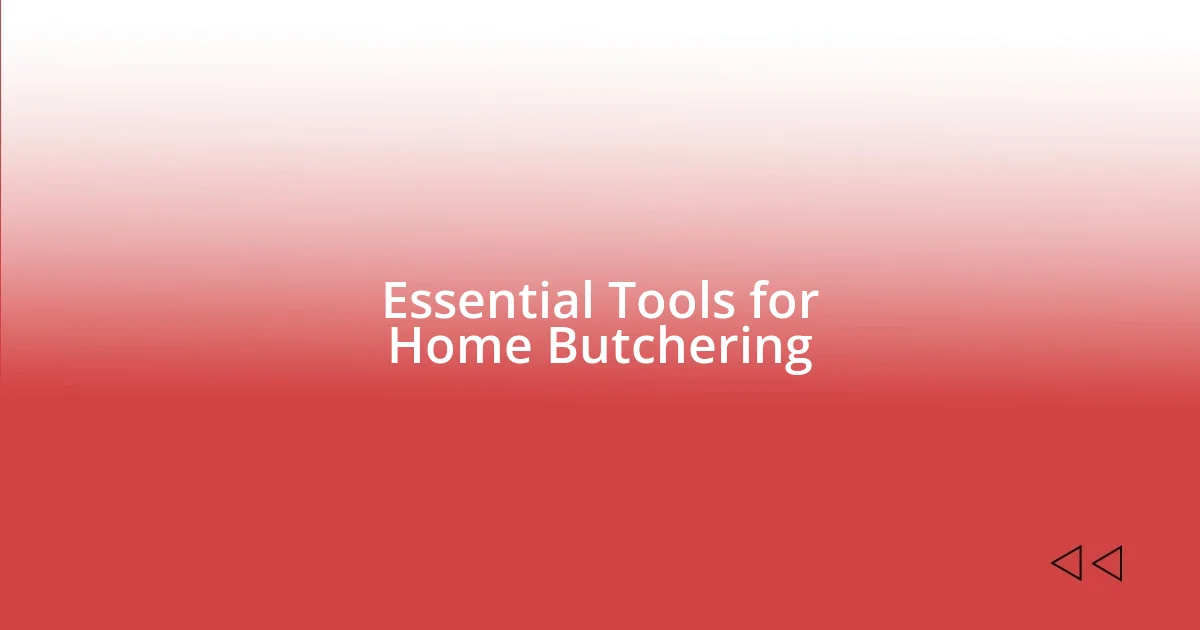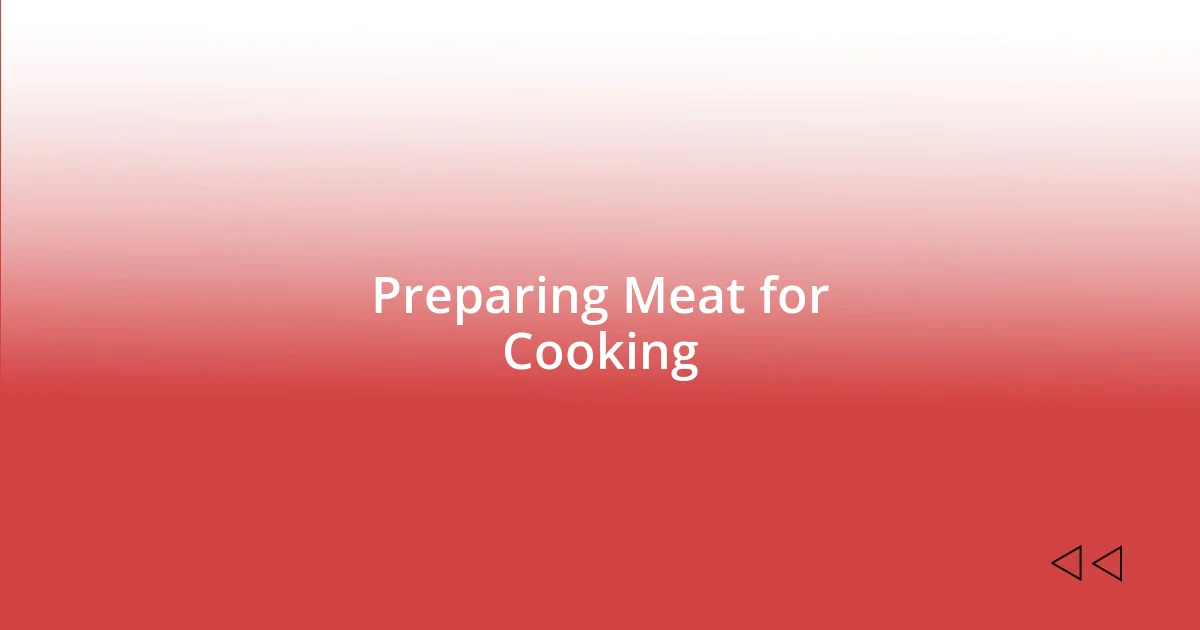Key takeaways:
- Home butchering fosters a deeper connection to food, emphasizing respect for the life of the animal and enhancing appreciation for culinary traditions.
- Choosing the right butchering class is crucial; factors like instructor expertise, class size, and hands-on experience can significantly impact learning and enjoyment.
- Patience, resourcefulness, and community engagement are essential lessons learned, enhancing the overall butchering experience and fostering a sense of shared culinary artistry.

Introduction to Home Butchering
Home butchering is a practice that has seen a resurgence in recent years, and I find it fascinating how much it connects us to our food sources. I remember the first time I processed a whole chicken; it felt both intimidating and exhilarating. The act of breaking down the animal made me appreciate each cut of meat in a way I’d never thought possible.
Engaging in home butchering can evoke a range of emotions—from a sense of pride in self-sufficiency to a profound respect for the life that was given. Have you ever considered how many hands touch the meat you buy at the store? This personal experience pushes us to acknowledge the effort that goes into raising and preparing these animals, deepening our relationship with food.
Through my journey of home butchering, I discovered that it’s not just about meat; it’s about tradition and mindfulness. Each slice and cut carries a story, connecting me to generations before. How many of us take the time to reflect on the origins of our meals? It’s an eye-opening experience that transforms our culinary approach, making me think twice about every meal I prepare.

Why I Chose Home Butchering
Choosing to embark on the journey of home butchering came from a desire for greater control over what I was putting on my family’s dinner plate. I vividly remember the first time I handled a whole pig; the smell of the fresh meat was both intoxicating and overwhelming. As I navigated the process, I realized that crafting our meals from scratch heightened my appreciation for the food itself and the culinary art behind it.
For me, home butchering has been about fostering sustainability and ethical eating practices. It felt rewarding to know the animal’s origins and ensure it was treated with respect. One particularly powerful moment was when I shared a home-cooked meal with friends, made from meat I had personally processed. Their reactions, filled with surprise and admiration, strengthened my belief that this practice not only nourished us but also created lasting memories.
I also came to appreciate the financial benefits of butchering at home. Initially, I invested in the necessary tools, but it quickly became apparent that the savings from purchasing whole animals rather than pre-packaged meat could be significant. When I calculated the cost difference, I was amazed at how much more I could stretch my budget while enjoying high-quality products. It felt like a win-win situation—both my wallet and my palate were happy.
| Reasons | Insights |
|---|---|
| Control Over Food | Increased appreciation for culinary artistry and food origins. |
| Sustainability | Engaging in ethical eating practices and creating lasting memories with loved ones. |
| Financial Benefits | Significant savings on high-quality meat purchases. |

Finding the Right Butchering Class
Finding the right butchering class can be a game changer. When I first approached this learning process, I felt overwhelmed by my options. I scoured local listings and online reviews, searching for a class that resonated with my goals and comfort level. Ultimately, the connections I made with instructors and fellow participants turned out to be more valuable than I anticipated.
Here are a few key factors to consider when selecting a class:
- Instructor Expertise: Look for classes led by professionals or experienced butchers who can offer insights beyond the basics.
- Class Size: Smaller classes allow for more personal attention and hands-on practice, enhancing your learning.
- Curriculum Focus: Some classes emphasize specific meats or techniques, so choose one that aligns with your interests.
- Hands-On Experience: Seek out opportunities that prioritize practical skills over lecture; this was a pivotal aspect of my own learning journey.
- Location and Schedule: Consider convenience; a class that fits your timetable will help maintain your motivation.
Being intentional about your choices can transform your butchering skills into something truly rewarding. I still cherish the friendships I forged during my first class—it felt like building a community around this art. Those shared experiences made the learning curve feel less daunting and ignited a passion within me that continues to grow.

Essential Tools for Home Butchering
When I think about essential tools for home butchering, a good knife is always at the top of my list. The feel of a sharp, well-balanced knife in my hand brings a sense of confidence to the process. I remember my first attempt—it took me far too long to break down that pig simply because I mishandled a dull knife. Investing in a quality boning knife not only makes the task easier but also more enjoyable, transforming what could be a chore into a true craft.
Another vital gadget is the cutting board. I learned quickly that a sturdy, large board can make a world of difference. It wasn’t until my cutting board slipped during a big project that I understood how important stability is. I now opt for a heavy, non-slip model that provides a solid foundation. This reduces accidents and allows me to focus on the artistry of butchering rather than worrying about my workspace.
Lastly, I can’t stress enough the importance of a proper meat grinder. Initially, I thought I could get away with a manual one, but oh, how wrong I was! The first time I tried grinding meat without enough power behind it was a comical disaster—pieces flew everywhere! Now, with an electric grinder, I save so much time and effort. Plus, the ability to customize my own blends for sausages has turned my cooking experience into a whole new adventure. Isn’t it amazing how these tools can shape not just the process, but also the quality of the meals we prepare?

Step by Step Butchering Techniques
When it comes to butchering meat, becoming familiar with each cut is essential. For example, I remember the first time I tried to break down a chicken. It felt like a puzzle with instructions in a foreign language. I focused on identifying the joints and natural seams in the meat, which helped guide my knife and truly taught me the importance of precision. A clean-cut reduces waste and respects the animal we’re working with.
As I moved on to larger animals, like pigs or lambs, I learned about sections like the shoulder and haunches. Each part has its own characteristics and cooking methods, which can be incredibly rewarding once you grasp them. I still recall my excitement when I successfully separated a pork loin from the shoulder, feeling like I had unlocked a hidden treasure in the process. That sense of achievement made all the hours of learning feel worthwhile. Have you ever experienced the thrill of mastering a new skill?
When it comes to techniques, I find that following a systematic approach works best. I start with the animal’s skin, making deliberate incisions to help me access the meat beneath. Each cut requires confidence and control, something that improves with practice. To this day, maintaining a consistent rhythm during butchering feels like a dance to me. It’s fascinating how rhythm and flow can transform a daunting task into a beautiful and rewarding experience. Isn’t it wonderful how the right approach can elevate even the most challenging of tasks?

Preparing Meat for Cooking
Prepping meat for cooking is an art that goes beyond just cutting it into pieces. I vividly remember the first time I had to remove the silver skin from a tenderloin. It felt like a little battle at first—my knife was slipping, and I could feel the tension building. But once I found the right angle and approach, it was like unlocking a secret door to a more tender, flavorful dish. That moment really highlighted for me how important proper preparation is; it not only makes the meat easier to cook but also enhances the overall flavor.
The seasoning process is just as crucial to preparing meat. After my initial butchered attempts, I realized that just throwing some salt on my meat didn’t cut it—literally and figuratively! I started experimenting with marinades and dry rubs. One unforgettable experience was when I allowed a pork shoulder to sit with spices overnight. The transformation it underwent by the time I threw it on the grill was incredible, boasting flavors that melted in my mouth. Have you ever had a dish turn out so much better than you expected? It’s moments like those that inspire me to keep refining my techniques.
Finally, let’s talk about resting your meat. I’ll let you in on a little secret: my first steak didn’t get a chance to rest, and boy, did I regret that! The juices poured out onto the cutting board instead of staying inside, leading to a dry meal that left me disappointed. Now, I always plan for a proper resting period, giving the meat time to reabsorb its juices. It’s fascinating how something so simple can elevate the dining experience. Has resting ever made a difference in your meals? I can assure you, it makes all the difference in achieving that tender, juicy perfection we all crave!

Lessons Learned and Final Thoughts
One significant lesson I’ve learned from my home butchering journey is the importance of patience. I remember a day when I was in such a rush to finish processing a rabbit that I made careless cuts. The result was far from pleasing, and it frustrated me. In that moment, I realized that rushing through the process not only affects the quality of the meat but also diminishes the respect for the animal and the craft. Have you ever noticed how taking your time can lead to a better outcome in any hobby? It’s a simple truth that has resonated deeply with me in this journey.
Another realization came to light when I discovered the value of knowing my local resources. After my first butchering, I found myself overwhelmed with leftover parts I didn’t know how to use. One day, a neighbor shared a delicious recipe for making broth with the bones I had set aside, which opened a new door for me. This experience taught me that every part of the animal has its purpose. It makes me wonder: how often do we overlook opportunities to use all available resources in our cooking?
Lastly, I can’t overemphasize the sense of community that surrounds this craft. Engaging with fellow butchers and home cooks has enriched my experience immensely. I remember attending a workshop where seasoned experts shared their insights and stories, which gave me a newfound appreciation for the skill and artistry involved in butchering. It’s a reminder that every cut of meat carries history and ties us to our food sources. Have you ever felt that sense of connection to your meals? It’s these relationships and shared experiences that truly deepen my love for the craft.















